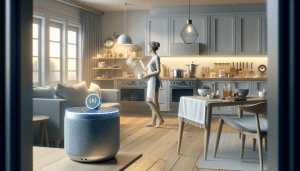Smart Homes Unlocked What You Might Not Expect
Aiden Foster August 30, 2025
Explore what makes smart home technology so appealing and how new advancements are reshaping everyday living. This guide unpacks automation, security, energy savings, privacy, and the rapid rise of connected devices, helping readers understand what really matters most with smart home tech.
How Smart Home Technology Is Changing Daily Life
Smart home technology has redefined what it means to interact with surroundings, merging convenience and connectivity. Tools like voice assistants, programmable thermostats, smart lights, and connected appliances are making homes far more responsive to daily routines. Instead of manually flipping switches or adjusting settings, automation lets people focus on what matters most. It’s not just about luxury; it’s about streamlining daily activities and improving overall home safety. A major draw is the way these intelligent systems communicate behind the scenes, linking your devices for smooth operation throughout your house.
What surprises many is how quickly these systems have become accessible. Devices once restricted to high-end smart buildings are now common in regular households. While home automation originally focused on lighting and entertainment, now smart security and climate control rank among the fastest-growing segments. For users, this shift means greater energy efficiency and the ability to adapt home environments to individual preferences. For example, smart thermostats allow for optimized heating and cooling schedules, helping to lower energy bills and shrink carbon footprints. The adaptation of older homes to use these devices is also a game-changer for sustainability. (Source: https://www.energy.gov/energysaver/smart-home-tech)
Daily conveniences can go well beyond touchless entry or voice-activated music. Smart refrigerators can track groceries and expiration dates, notifying about what needs to be restocked. Homeowners benefit from the integration of smart cameras and sensors that help monitor for unexpected activity or leaks, offering timely alerts. All these features support busy schedules while delivering peace of mind. Adoption may vary by age group and household size, but the universal benefit is a home environment that ‘learns’ and adapts. The path to more intelligent living is becoming less complex and more accessible than ever before.
Automation Secrets That Power Connected Homes
What powers smart homes goes deeper than gadgets; it’s the concept of automation. Behind each routine, sensors, cloud systems, and AI are constantly working together. Automation can perform simple tasks, such as turning off lights when no motion is detected, or complex routines that coordinate security cameras, alarms, and exterior lights simultaneously. This seamless interplay often uses the Internet of Things (IoT)—the connective tissue that makes it all possible. As more devices join this network, automation grows smarter and more responsive to user behavior.
Many users don’t realize how much customization is available. Most smart home ecosystems let users tailor automations for morning and evening routines, guest access, or even emergency responses. Some ecosystems even leverage machine learning, adjusting future automations based on continued interaction and collected data over time. This means the longer systems are used, the more intuitive they become. For instance, automated blinds can adjust based on sunlight, while voice-activated systems can detect preferences in music or temperature. (Source: https://www.nist.gov/itl/ssd/internet-things-iot)
Automation isn’t just about comfort or novelty—it supports accessibility needs and helps individuals with limited mobility. Smart door openers, voice-controlled lighting, and adaptive devices make independent living more feasible. Home tech also enables remote care and monitoring, connecting loved ones through movement alerts or video check-ins. Particularly for elderly users, these tools can promote security and well-being while offering peace of mind for families. As these systems become more sophisticated, expect automation’s reach to grow wider in healthcare and assisted living, highlighting another often-overlooked benefit of smart home adoption.
The True Impact of Smart Home Security
Security is often the entry point for new users who want to explore smart home innovations. Devices like intelligent door locks, remotely monitored cameras, and motion sensors now provide a strong layer of protection. What sets smart security apart is the ability to receive real-time alerts or review activity feeds via mobile apps, no matter where you are. Remote monitoring means people can observe package deliveries, answer the door from another location, or review video playback after an unexpected noise. (Source: https://www.safewise.com/resources/smart-home-security-guide/)
But there’s more to consider. Smart security isn’t only about thwarting intruders; it also detects hazards like smoke, water leaks, and carbon monoxide, sometimes even contacting emergency services if configured. This proactive approach helps reduce the risk of costly damages or hazards going unnoticed. Some systems integrate security and home automation, so lights turn on and video starts recording if motion is detected at night. This cross-functionality boosts both convenience and deterrence. However, it’s important to review privacy settings and data sharing options provided by each device, ensuring the safest, most confidential experience possible.
Many homeowners have also adopted automation to simulate presence while they’re away, randomly cycling lights or adjusting blinds. This psychological deterrent adds another layer of defense, making empty homes less obvious to outsiders. For landlords or property managers, remote control over access enables smart key exchanges and monitoring vacant properties. As these security features continue to evolve, the key lies in balancing convenience with robust safeguards and informed management of connected devices.
Energy Efficiency and Smart Homes
One major advantage often praised by industry experts is energy efficiency. Smart devices help conserve electricity and water, lowering utility bills while minimizing environmental impact. Programmable thermostats, smart plugs, and water-saving irrigation systems only run when needed. Many smart home hubs provide real-time data on consumption, allowing users to spot inefficiencies and make smarter choices. Tracking usage over weeks or months helps set realistic goals, leading to long-term savings. (Source: https://www.epa.gov/greenhomes/energy-efficient-home-improvements)
The ability to monitor usage patterns is a game-changer for sustainability. Lighting schedules or smart showers optimize routines with little sacrifice. Smart meters, increasingly adopted by utilities, provide detailed breakdowns of daily and hourly usage. Connected appliances can operate during off-peak hours, easing strain on the grid and maximizing cost efficiency. These features attract homeowners with both budget and environmental interests. Some insurance companies now offer lower premiums to those who invest in energy-aware, smart home upgrades.
Taking efficiency further, some systems integrate renewable energy sources, such as rooftop solar paired with battery backups, which help store and manage clean power for household use. In some regions, this allows households to reduce or sometimes even eliminate their grid dependency. As technology matures, energy efficiency becomes more customizable—adapting to weather changes, occupancy, or lifestyle shifts. Modern homes are likely to embrace these features as default, not just as a special upgrade, marking a shift in what society considers ‘standard’ efficiency.
The Privacy Conversation in Smart Homes
With new possibilities in convenience come emerging concerns over privacy. Every connected device represents another potential entry point for data collection—something both manufacturers and users must take seriously. Many smart assistants and cameras collect voice, video, or behavioral data. Typically, this information supports improved user experience, but it also lies at the heart of debates around data ownership, third-party access, and long-term digital security. (Source: https://www.ftc.gov/tips-advice/business-center/small-businesses/cybersecurity/smart-home-devices)
Smart home users should become familiar with privacy controls, including which companies hold and process their data. Many devices allow for local storage instead of cloud uploading, offering an extra layer of privacy. Two-step verification, password changes, and device updates provide further protection. Experts stress the importance of reading privacy agreements and understanding how data is used, making informed choices when selecting vendors or brands. Ultimately, privacy begins with proactive steps during device setup and continues through regular maintenance and monitoring.
Policymakers and watchdog groups are increasingly focusing on digital rights, seeking strong regulations to protect personal data within domestic spaces. Some smart ecosystems are moving towards decentralized or end-to-end encrypted platforms to give users more control. Technological solutions exist, but user awareness is crucial. By following best practices, users can enjoy the convenience and efficiency of smart homes while minimizing risks related to privacy breaches or unauthorized surveillance. Responsible device use remains a top priority for any connected home.
The Future of the Smart Home: What’s Next?
Looking ahead, the horizon for smart homes includes even deeper integration and intelligence. Homes will continue to shift from simple automation to predictive environments using AI and machine learning. As more people embrace smart lighting, security, and climate control, future systems may anticipate needs, suggesting schedules or adjusting automatically, not just reacting to current input. Cross-brand compatibility is improving, meaning households can assemble systems from different manufacturers without losing functionality. (Source: https://www.cnet.com/home/smart-home/the-future-of-smart-homes/)
In the coming years, expect smart homes to evolve alongside other innovations, such as 5G and edge computing, making connectivity more reliable and reducing lag time in automation. Research institutions are already exploring environmental sensing, health monitoring, and advanced robotics as part of residential tech. These advances may empower homes to detect air quality changes, recognize fall risks, or provide early alerts related to health and wellness. The smart home, then, transitions into a system that learns, protects, and supports well-being on many fronts.
Businesses, city planners, and sustainability advocates are also recognizing the potential of interconnected homes for larger energy savings and data-driven urban environments. Shared systems, bulk data analysis, and neighborhood-scale automation could transform how communities manage energy and safety collectively. As smarter neighborhoods emerge, the ripple effect will be felt well beyond the walls of individual homes, setting new expectations for modern living worldwide.
References
1. U.S. Department of Energy. (n.d.). Smart Home Technology. Retrieved from https://www.energy.gov/energysaver/smart-home-tech
2. National Institute of Standards and Technology. (n.d.). Internet of Things (IoT). Retrieved from https://www.nist.gov/itl/ssd/internet-things-iot
3. SafeWise. (n.d.). Smart Home Security Guide. Retrieved from https://www.safewise.com/resources/smart-home-security-guide/
4. U.S. Environmental Protection Agency. (n.d.). Energy Efficient Home Improvements. Retrieved from https://www.epa.gov/greenhomes/energy-efficient-home-improvements
5. Federal Trade Commission. (n.d.). Smart Home Device Security. Retrieved from https://www.ftc.gov/tips-advice/business-center/small-businesses/cybersecurity/smart-home-devices
6. CNET. (n.d.). The Future of Smart Homes. Retrieved from https://www.cnet.com/home/smart-home/the-future-of-smart-homes/








